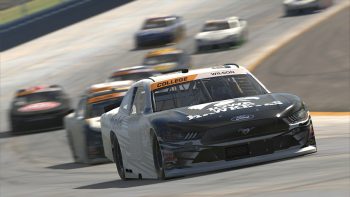
The Kitchen Sink: Setting Up Iowa
April 7th, 2014 by JaimeB
Previously: Article 1, Article 2
Iowa is one of the most unique tracks on the IndyCar circuit. It is essentially a replica of Richmond with higher banks and in general is a bit longer. As the fastest short track out there, Iowa provides some crazy sim-racing. For the past couple seasons the track was flat-out all the way around, unless you cooked the right front tire. With this weather and the fact that it is during the day, the car gets a massive push in Turns Three and Four. If you have a solid Richmond base set, that is a great starting point, just adjust your cambers and gears.
For the purpose of this article however, we will start with the Iowa Fixed set with 5 rear ARB arm and 20 Weight Jacker. The set as it is will snap loose the moment you get out of the pits. The first thing we will change is the rear toe. Let’s make the left rear -3 and the right rear +3 for the time being. If you go out and run this again, the set will feel much more stable. Now you will start to feel that mid corner push come into play with a slight snap loose on corner exit, but it should be much more stable and on top of that it should only be one tenth off the pace of other drivers.
The second change I want to do is move the weight ballast all the way backwards. This will definitely make the car a lot looser and hurt our Turn Four exit even more. But, we will fix that soon. Because the car is stepping out, the first thing we can do to fix this is lower the right rear spring rate. Try lowering this significantly until it is comfortable for you. If making this change fails you upon tech inspection, check the rear ARB preload and lower that to make the car pass tech. Then, hit the track and feel the difference that has been made, until you have found a value you like. For me, I went and ran just three laps and could feel the car was far more stable, but also suffered more understeer all the way through Three and Four now.
The next change we make can remedy that situation a bit. You could raise the right rear spring perch slightly, which will make up for some that was lost when softening the rear spring. However, I would like to shift attention to the front of the car. The front toe could be adjusted to move from a stable approach to a value that would allow the car to turn more easily. Try changing this. With all of this done however, the car will still be very tight in the center. I would recommend removing the front anti-roll bar as this will help get the car through the center of the corner without binding up. With all these changes I was able to get the car a couple hundredths faster on the opening of the stint, and still able to hang full throttle for the remainder of the run without pushing into the wall like previous variations.
My last step to creating a stable setup that is a bit quicker than the fixed set would be to optimize the left side cambers. The left rear camber is all sorts of screwed up and the left front can be made better. Once you get the left side right, double check the right sides and make sure that you didn’t get them slightly off balance when you were changing other things. I would also recommend changing the aerodynamic settings and dampers to your preference if you feel the need to.
If this isn’t enough for you and you want even more pace, then this last bit is for you. You can significantly improve the turning ability of the car in Three and Four by stiffening the front suspension and lowering the ride height to a bit more, but make sure you aren’t scraping the ground. You will want to try a little of both spring and perch adjustments. Furthermore, the left rear spring was one area of the car I left untouched, this is one part of the car that you can use to help the car turn in the center, so you may want to try playing with that, but I think the default one is ok. Probably the biggest point of concern would be the right rear. Since we significantly lowered the rear right spring rate, we should probably counter with spring perch. I did notice that the ride height was a bit low, so it is probably a good idea to find pace by bringing the ride height up a bit by replacing the softened spring with some spring perch.
You probably have noticed this article was more general. I really want people to get out there and try the changes themselves rather than just plug numbers in and rely on what I tell them. I would like feedback on this style, so please post in the comments section if you liked this. But, in order to keep you guys from hanging. I am going to post a little recap below.
- Fixed set as a base
- Reverse rear toes
- Lower right rear spring rate, about half of original
- Throw away the front anti-rollbar
- Adjust front toe to a more positive value if you want to.
- Fix cambers
- Fix preload issues (bring close to 0, if suffering snap oversteer try -48)
- Run 20 WJ and 5 rear ARB arms incar settings.
- Ask questions.

















































